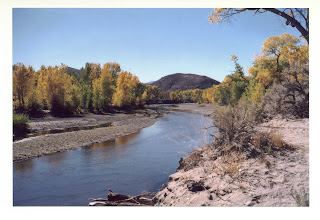 There are a number of ways of finding water. Some
walk over the land with a forked willow limb in a practice called ‘dowsing’.
Others, perhaps more scientifically, study the geology carefully…still others
look at the vegetation. Some, like Craig Childs (The Secret Knowledge of Water)
spend days, even months, in the field under very dangerous conditions, in order
to find water. My son Kevin and I recently used history and a little of the
above (but not dowsing or danger) to find water.
There are a number of ways of finding water. Some
walk over the land with a forked willow limb in a practice called ‘dowsing’.
Others, perhaps more scientifically, study the geology carefully…still others
look at the vegetation. Some, like Craig Childs (The Secret Knowledge of Water)
spend days, even months, in the field under very dangerous conditions, in order
to find water. My son Kevin and I recently used history and a little of the
above (but not dowsing or danger) to find water.
We were talking one day when he mentioned having read somewhere
of the building of the Virginia & Truckee Railroad (1865-1959) in the northwestern
part of the colorful US State of Nevada. The book or books indicated that upon
reaching a certain mileage, those building the railroad bed had encountered
water. Kevin located the possible location
and passed the information on to me. I
used Google Earth to follow the still existing railroad bed, sans tracks and
ties, and right where it should be was a stand of green vegetation.

In late October of 2013, along with the Nevada gathering of
our family, we walked about three kilometers along the old roadbed until we
came to the stand of willow I had seen on the Google Map. At first it was difficult to tell, but after
looking more carefully we saw the water!
There, at the base of what is called a ‘cut’ in the slope of the
hillside, we found a shallow pool, 3-4 meters long, of very clear water. The soil around the pool was hard-packed sand
and gravel and did not take the impression of animal tracks very well. We could
not tell what animals visited the site but in these very arid lands, this water
is valuable to many species. Our visit
took place on the driest day of the year and yet there was water in this
shallow basin. It snowed in northwestern Nevada the day after our visit to the seep.






.JPG)






.jpg)












.JPG)
















